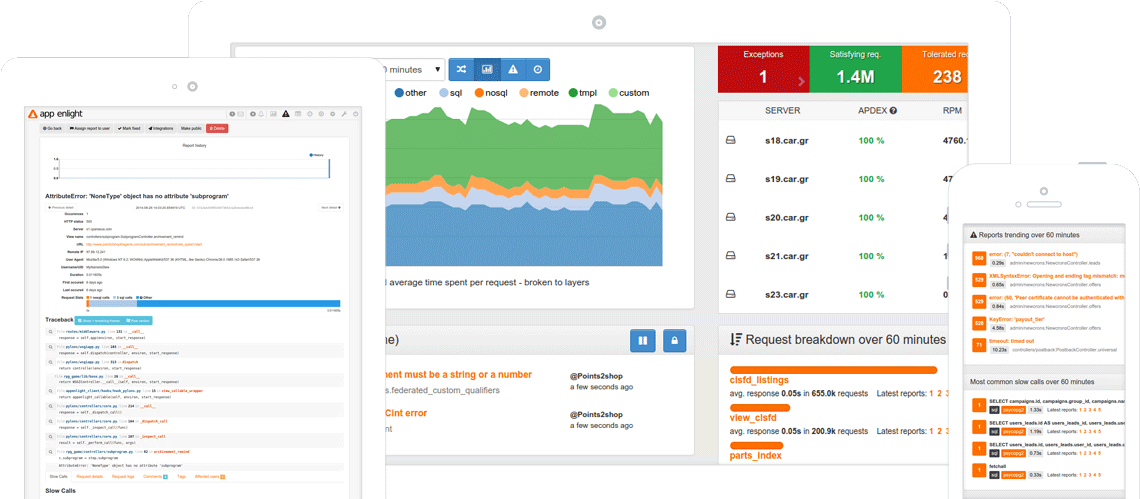README.md
112 lines
| 2.7 KiB
| text/x-minidsrc
|
MarkdownLexer
/ backend / README.md
| r161 | AppEnlight | |||
| ----------- | ||||
| r191 | Performance, exception, and uptime monitoring for the Web | |||
|  | ||||
| r161 | Automatic Installation | |||
| ====================== | ||||
| r195 | Use the ansible or vagrant scripts in the `automation` repository to build complete instance of application. | |||
| r161 | You can also use `packer` files in `automation/packer` to create whole VM's for KVM and VMWare. | |||
| r195 | https://github.com/AppEnlight/automation | |||
| r161 | Manual Installation | |||
| =================== | ||||
| To run the app you need to have meet prerequsites: | ||||
| r185 | - python 3.5+ (currently 3.6 tested) | |||
| r177 | - running elasticsearch (6.6.2 tested) | |||
| - running postgresql (9.5+ required, tested 9.6 and 10.6) | ||||
| r161 | - running redis | |||
| Install the app by performing | ||||
| pip install -r requirements.txt | ||||
| python setup.py develop | ||||
| Install the appenlight uptime plugin (`ae_uptime_ce` package from `appenlight-uptime-ce` repository). | ||||
| r185 | For production usage you can do: | |||
| pip install appenlight | ||||
| pip install ae_uptime_ce | ||||
| r161 | After installing the application you need to perform following steps: | |||
| 1. (optional) generate production.ini (or use a copy of development.ini) | ||||
| r189 | appenlight-make-config production.ini | |||
| r161 | ||||
| r195 | 2. Setup database structure (replace filename with the name you picked for `appenlight-make-config`): | |||
| r161 | ||||
| r189 | appenlight-migratedb -c FILENAME.ini | |||
| r161 | ||||
| 3. To configure elasticsearch: | ||||
| r189 | appenlight-reindex-elasticsearch -t all -c FILENAME.ini | |||
| r161 | ||||
| 4. Create base database objects | ||||
| (run this command with help flag to see how to create administrator user) | ||||
| r189 | appenlight-initializedb -c FILENAME.ini | |||
| r161 | ||||
| 5. Generate static assets | ||||
| r189 | appenlight-static -c FILENAME.ini | |||
| r161 | ||||
| Running application | ||||
| =================== | ||||
| To run the main app: | ||||
| r195 | pserve FILENAME.ini | |||
| r161 | ||||
| To run celery workers: | ||||
| celery worker -A appenlight.celery -Q "reports,logs,metrics,default" --ini FILENAME.ini | ||||
| To run celery beat: | ||||
| celery beat -A appenlight.celery --ini FILENAME.ini | ||||
| r195 | To run appenlight's uptime plugin (example of uptime plugin config can be found here | |||
| https://github.com/AppEnlight/appenlight-uptime-ce ): | ||||
| r161 | ||||
| r195 | appenlight-uptime-monitor -c UPTIME_PLUGIN_CONFIG_FILENAME.ini | |||
| r161 | ||||
| Real-time Notifications | ||||
| ======================= | ||||
| You should also run the `channelstream websocket server for real-time notifications | ||||
| r195 | channelstream -i CHANELSTRAM_CONFIG_FILENAME.ini | |||
| r192 | ||||
| Additional documentation | ||||
| ======================== | ||||
| Visit https://getappenlight.com for additional server and client documentation. | ||||
| r161 | Testing | |||
| ======= | ||||
| To run test suite: | ||||
| py.test appenlight/tests/tests.py --cov appenlight (this looks for testing.ini in repo root) | ||||
| Development | ||||
| =========== | ||||
| To develop appenlight frontend: | ||||
| cd frontend | ||||
| npm install | ||||
| grunt watch | ||||
